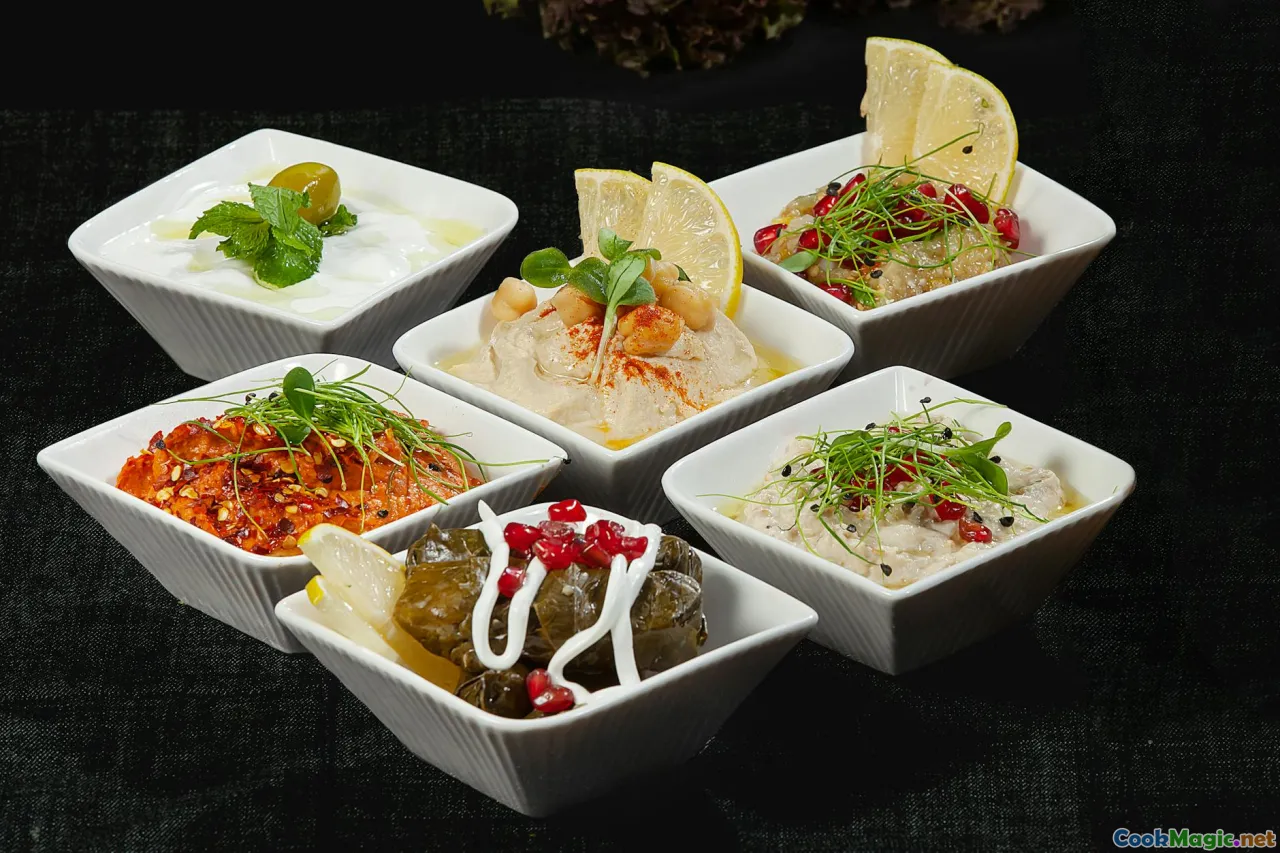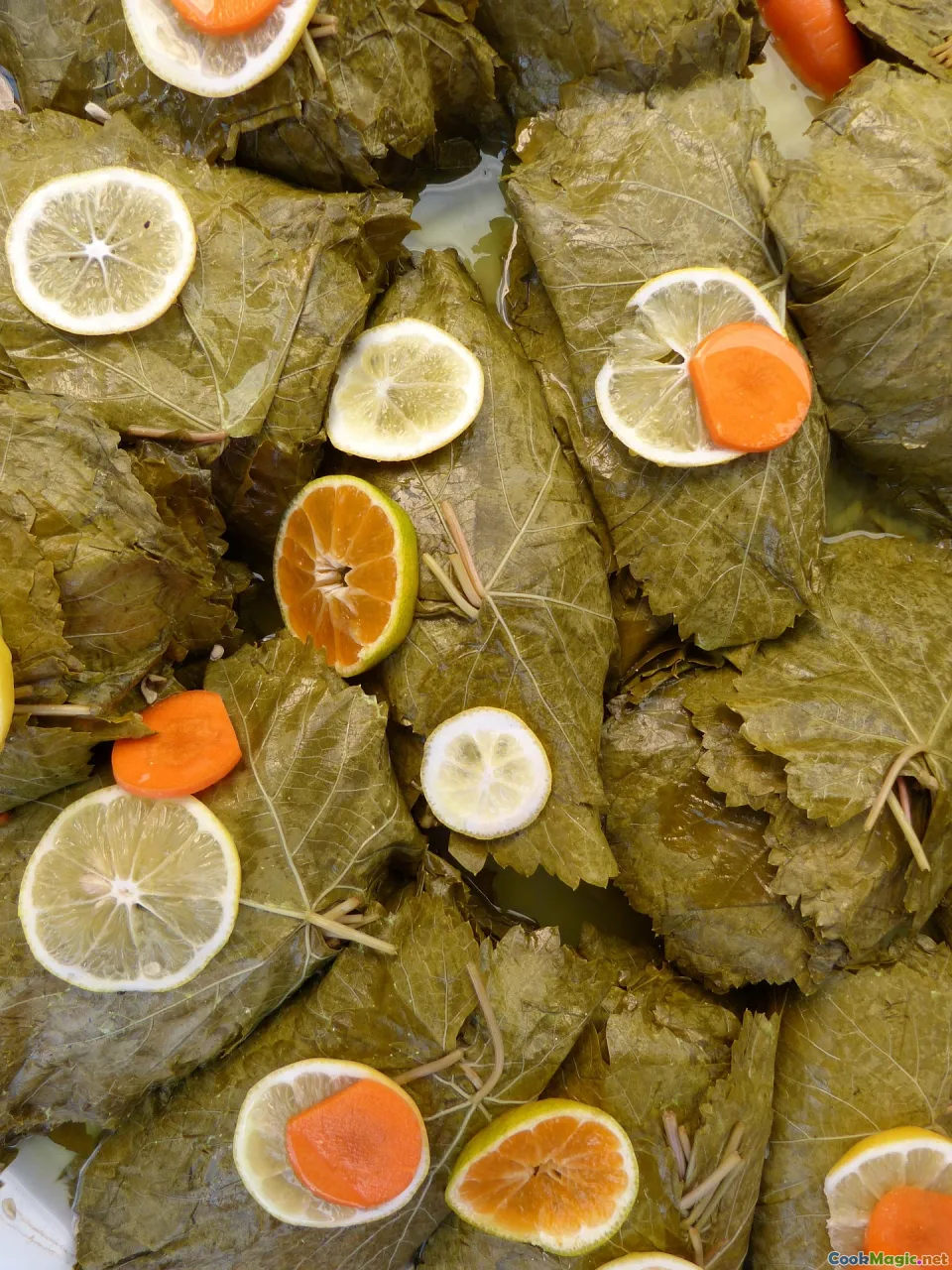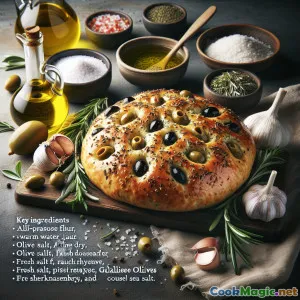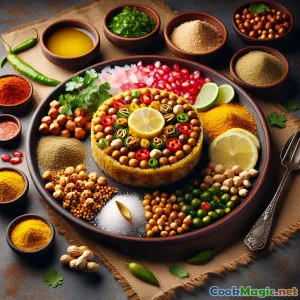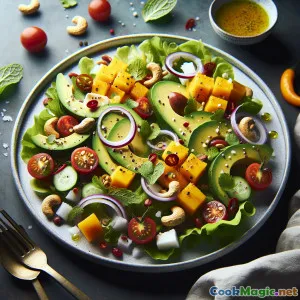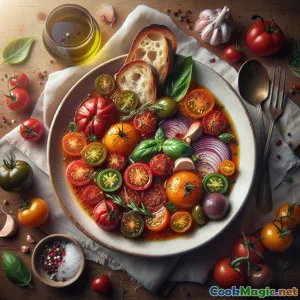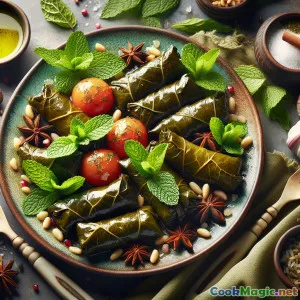
Hojas de parra rellenas al estilo de Jerusalén con menta
(Jerusalem Minted Stuffed Grape Leaves)
(0 Reseñas)0
151
octubre 12, 2025
Informar de un problema
Ingredientes
-
45 leaves Hojas de parra en salmuera
(Rinsed well; reserve any torn leaves to line the pot)
-
200 grams Arroz de grano corto (enjuagado)
(Egyptian, Calrose, or sushi rice for tender, cohesive filling)
-
150 grams Cebolla amarilla, finamente picada
(About 1 medium onion)
-
20 grams Hojas de menta fresca, picadas
(Key Jerusalem flavor; do not skip)
-
25 grams Perejil fresco picado
(Flat-leaf preferred)
-
10 grams Eneldo fresco, picado
(Adds delicate herbaceous sweetness)
-
40 grams Nueces de pino, ligeramente tostadas
(For buttery crunch)
-
6 tbsp Aceite de oliva virgen extra
(Divided between filling and braise)
-
3 cloves Ajo (picado)
(Freshly minced for best aroma)
-
1 tsp Pimienta de Jamaica molida
(Classic Levantine warmth)
-
0.5 tsp Canela molida
(Subtle, fragrant backdrop)
-
1.5 tsp sal de mar fino
(Adjust to taste; leaves bring salt too)
-
1 tsp Pimienta negra
(Recién molido)
-
150 grams Tomate (picado)
(For layering and subtle sweetness)
-
6 tbsp Jugo de Limón Fresco
(Alrededor de 2 limones grandes)
-
1 tsp Ralladura de limón
(Brightens the broth)
-
500 ml Caldo de verduras (o agua)
(Enough to barely cover the rolls)
-
250 grams Cordero molido
(Optional Jerusalem-style variation for a heartier dolma)
-
1 tsp Azúcar granulado
(Equilibrio de la acidez)
-
2 tsp Melaza de granada
(Tangy-sweet depth in the braising liquid)
-
2 leaves Hojas de laurel
(Aromatic layer for the pot)
-
1 stick Rama de canela
(Optional extra warmth in the braise)
-
1 portion Menta extra y gajos de limón (para servir)
(For garnish at the table)
(Rinsed well; reserve any torn leaves to line the pot)
(Egyptian, Calrose, or sushi rice for tender, cohesive filling)
(About 1 medium onion)
(Key Jerusalem flavor; do not skip)
(Flat-leaf preferred)
(Adds delicate herbaceous sweetness)
(For buttery crunch)
(Divided between filling and braise)
(Freshly minced for best aroma)
(Classic Levantine warmth)
(Subtle, fragrant backdrop)
(Adjust to taste; leaves bring salt too)
(Recién molido)
(For layering and subtle sweetness)
(Alrededor de 2 limones grandes)
(Brightens the broth)
(Enough to barely cover the rolls)
(Optional Jerusalem-style variation for a heartier dolma)
(Equilibrio de la acidez)
(Tangy-sweet depth in the braising liquid)
(Aromatic layer for the pot)
(Optional extra warmth in the braise)
(For garnish at the table)
Nutrición
- Porciones: 6
- Tamaño de porción: 4 rolls (220g)
- Calories: 320 kcal
- Carbohydrates: 36 g
- Protein: 6 g
- Fat: 16 g
- Fiber: 4 g
- Sugar: 2 g
- Sodium: 680 mg
- Cholesterol: 0 mg
- Calcium: 120 mg
- Iron: 3.5 mg
Instrucciones
-
1 - Rinse and prep grape leaves:
Rinse brined grape leaves under cool water to remove excess salt. Pat dry. Set aside the neatest leaves for rolling and any torn ones for lining the pot.
-
2 - Sauté Aromatics:
Warm 2 tbsp olive oil in a skillet over medium heat. Add minced onion and a pinch of salt; cook until translucent. Stir in garlic for 30 seconds until fragrant.
-
3 - Build the Filling:
In a bowl, combine rinsed rice, sautéed aromatics, chopped mint, parsley, dill, pine nuts, allspice, cinnamon, black pepper, and 0.5 tsp salt. Mix until evenly coated.
-
4 - Optional lamb variation:
If using ground lamb, brown briefly in 1 tsp olive oil with a pinch of salt and allspice. Fold 150–200 g into the rice mixture; reserve the rest for layering.
-
5 - Set up rolling station:
Place a leaf shiny side down, stem toward you. Trim any tough stem. Keep a tray for finished rolls and a damp towel to prevent drying.
-
6 - Roll the dolmas:
Place 1–1.5 tbsp filling near the leaf base. Fold sides inward and roll tightly toward the tip, creating a compact cylinder. Repeat with remaining leaves.
-
7 - Line and layer the pot:
Line the pot base with torn leaves and bay leaves. Add a scattering of diced tomato and any remaining browned lamb (if used) for a savory base.
-
8 - Arrange rolls snugly:
Nestle rolls seam side down in concentric circles. Build a second layer if needed. Tuck in the cinnamon stick if using.
-
9 - Mix lemony braising liquid:
Whisk stock, lemon juice, remaining 4 tbsp olive oil, lemon zest, sugar, pomegranate molasses, and 1 tsp salt. Pour over rolls to barely cover.
-
10 - Weight and simmer gently:
Place a heatproof plate over the rolls to prevent floating. Bring to a gentle simmer, then cover and cook on low for 45–50 minutes until rice is tender.
-
11 - Rest and cool:
Remove from heat. Let rest, covered, 10 minutes, then uncover and cool slightly. This sets the rolls and concentrates flavors.
-
12 - Serve and Garnish:
Transfer carefully to a platter. Spoon a little cooking liquid over the top. Garnish with fresh mint and lemon wedges. Serve warm or at room temperature.
Rinse brined grape leaves under cool water to remove excess salt. Pat dry. Set aside the neatest leaves for rolling and any torn ones for lining the pot.
Warm 2 tbsp olive oil in a skillet over medium heat. Add minced onion and a pinch of salt; cook until translucent. Stir in garlic for 30 seconds until fragrant.
In a bowl, combine rinsed rice, sautéed aromatics, chopped mint, parsley, dill, pine nuts, allspice, cinnamon, black pepper, and 0.5 tsp salt. Mix until evenly coated.
If using ground lamb, brown briefly in 1 tsp olive oil with a pinch of salt and allspice. Fold 150–200 g into the rice mixture; reserve the rest for layering.
Place a leaf shiny side down, stem toward you. Trim any tough stem. Keep a tray for finished rolls and a damp towel to prevent drying.
Place 1–1.5 tbsp filling near the leaf base. Fold sides inward and roll tightly toward the tip, creating a compact cylinder. Repeat with remaining leaves.
Line the pot base with torn leaves and bay leaves. Add a scattering of diced tomato and any remaining browned lamb (if used) for a savory base.
Nestle rolls seam side down in concentric circles. Build a second layer if needed. Tuck in the cinnamon stick if using.
Whisk stock, lemon juice, remaining 4 tbsp olive oil, lemon zest, sugar, pomegranate molasses, and 1 tsp salt. Pour over rolls to barely cover.
Place a heatproof plate over the rolls to prevent floating. Bring to a gentle simmer, then cover and cook on low for 45–50 minutes until rice is tender.
Remove from heat. Let rest, covered, 10 minutes, then uncover and cool slightly. This sets the rolls and concentrates flavors.
Transfer carefully to a platter. Spoon a little cooking liquid over the top. Garnish with fresh mint and lemon wedges. Serve warm or at room temperature.
Más información sobre: Hojas de parra rellenas al estilo de Jerusalén con menta
Story and spirit
Jerusalem Stuffed Grape Leaves with Mint pays homage to a city where culinary threads from Jewish, Palestinian, Armenian, and broader Levantine communities are woven into one tapestry. Dolma—stuffed leaves—arrived in the region through centuries of trade and empire, but the Jerusalem touch is unmistakable: a generous hand with fresh mint, lemon-forward brightness, and a willingness to serve the dish warm or at room temperature for mezze, picnics, and holiday gatherings alike. While many versions across the Middle East use dill, parsley, and sometimes meat, the mint-led profile in this recipe anchors the aroma and links it to markets where bunches of green herbs perfume the morning air.
What makes this version unique
- Mint-centered filling: Rather than relegating mint to a garnish, it’s folded into the rice, infusing each bite with cool, fragrant lift that contrasts the mellow olive oil and sweet onion.
- Lemony braise: A braising liquid enriched with fresh lemon juice and a touch of pomegranate molasses creates a bright, gently tangy finish without overwhelming the herbs.
- Texture play: Short-grain rice turns tender and cohesive, pine nuts add buttery crunch, and the grape leaves remain supple yet structured after a slow simmer.
- Flexible tradition: Ground lamb is an optional inclusion—some Jerusalem families prepare meatless dolmas for dairy meals or fasting days, while others make a heartier, celebratory version with meat.
Tips for best results
- Choose the right leaves: Look for medium-sized brined grape leaves with intact veins. Rinse well to remove excess salt. If using fresh leaves, blanch briefly until pliable, then cool and pat dry.
- Rinse the rice: Washing until the water runs mostly clear prevents gummy fillings and ensures distinct, tender grains that still cling together.
- Keep rolls snug, not tight: Overpacking can split leaves; aim for compact rolls that still have room for rice to expand.
- Weight the pot: A heatproof plate keeps layers submerged for even cooking and prevents unraveling.
- Resting matters: A short rest post-cook allows starches to set, resulting in neat slices and tidy plating.
- Make-ahead friendly: These improve after a day in the fridge as flavors marry. To serve, bring to room temperature or warm gently with a splash of stock.
Serving ideas
- Mezze platter: Arrange with hummus, labneh, olives, pickled turnips, and warm pita. Drizzle with a thread of olive oil and scatter more fresh mint.
- Entree salad: Serve over chopped cucumber-tomato salad with tahini-lemon dressing for a vibrant lunch.
- Holiday table: Their tidy shape and glistening finish make them elegant for Rosh Hashanah, Easter, or family feasts.
Cultural notes
Dolma traverses borders and identities, but in Jerusalem it reflects the city’s layered histories. Herb-forward, citrusy profiles are common in home kitchens and neighborhood eateries, bridging shared tastes across communities. The dish’s portability and room-temperature appeal make it essential for picnics in parks, informal gatherings after prayers, and family visits. Mint, in particular, evokes tea houses and herb sellers who trim bunches to order; that fragrance carries straight into the kitchen.
Ingredient substitutions
- Rice: Short-grain is preferred for cohesion, but medium-grain can work. Avoid long-grain, which can become loose and dry.
- Nuts: Swap pine nuts with chopped toasted almonds or pistachios.
- Herbs: If dill isn’t available, use extra parsley and mint. Keep the mint as the hero.
- Stock: Water works; season a touch more. A vegetable bouillon cube can help, but reduce added salt.
- Pomegranate molasses: Optional but delightful. A teaspoon of honey with extra lemon offers a similar sweet-tart edge.
Troubleshooting
- Rolls unravelling: Place seam side down and ensure the plate weight is in place. A few torn leaves at the pot bottom also help stabilize.
- Too sour or too salty: Add a splash of water and a pinch of sugar to the braising liquid, then simmer a few more minutes.
- Rice undercooked: Add 50–100 ml hot stock, return to a gentle simmer for 5–10 minutes, and rest again.
Final thoughts
These Jerusalem-style stuffed grape leaves deliver balance: cool mint against warm spice, citrus brightness against olive oil richness, and delicate leaves encasing comforting rice. Whether you choose the vegetarian version or include a little lamb, the result is a platter that invites sharing—a dish that tastes like conversation, memory, and the welcome of a hospitable table.

